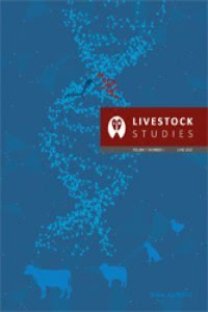SIĞIR EMBRİYOSUNUN DONDURULMASI VE TRANSFERİ
Bu çalışmada sığır emsriyolarının ülkemiz koşullarında dondurulması ve transferlerinden elde edilecek döl verimi sonuçlarının incelenmesi amaçlanmıştır. Araştırma materyalini Konya ve Lalahan Hayvancılık Araştırma Enstitüsüne ait 5 – 6 yaşlı Esmer ve 2 Siyah Alaca verici inek ile alıcı olarak kullanılan 2 – 4 yaşlı 14 Esmer düve oluşturmuştur. Araştırmada süperovulasyon ve sinkronizasyon, seksüel siklusun 10. gününde İ.M. olarak enjekte edilen 2500 IU.PMSG ve bu uygulamadan 48 saat sonra hem alıcı hemde vericilere uygulanan 25 mg dinoprost tromethamine ile sağlanmıştır. Embrioların elde edilmesi rekto vaginal yolla, 2 yollu foley kateteri yardımıyla ve Dulbecco fosfat buffer saline (M-PBS) kullanılarak gerçekleştirilmiştir. Dondurma solusyonu olarak 1.5 M gliserol ve 0.25 ml’lik payetler kullanıldı. Alıcılara nakil ise sikluslarının 6 – 7. gününde yine rekto vaginal yöntemle gerçekleştirildi. Çalışmada verici olarak kullanılan 3’ü Esmer 5 inekten, birisi süperovulasyona cevap vermemiş, 4 ineğin uterus yıkaması sonucu elde edilen toplam 24 ovum/embrio’dan transfer edilebilir bulunan 17 embriyo dondurulmuştur. Verici başına elde edilen ortalama ovum oranı (24/4) 6.0, transfer edilebilir embriyo oranı ise (17/4) 4.25 olarak belirlenmiştir. Alıcıların gebelikleri sikluslarının 21. gününde Radio İmmuna Assay (RIA)yöntemiyle kanda progesteron tayini ve 50. günde rektal palpasyon uygulanarak tespit edilmiştir. Nakli gerçekleştirilen 14 embriyodan 21. gün RIA bulgularına göre (14/6) % 42.85, 50. gün rektal muayene bulgularına göre (14/4) % 28.57 oranında gebelik sağlanmıştır. Elde edilen sonuçlara göre, embriyo transferinin başarısını etkileyen bir çok faktörün bulunduğu, gerek taze, gerekse dondurulmuş embriyo nakilleri ile ilgili çeşitli işlemlerde deneyim kazanılarak ve süperovulasyon ve sinkronizasyon tedavilerinde plasma veya süt progesteron seviyelerini esas alan bir proğram uygulaması ile gebelik oranlarının artırılabileceği sonucuna varılmıştır.
(Freezing and Transfering on Bovine Embriyos)
In this study, the result of freezing of cattle embriyos and reproductivity obtained by embryo transfer in Turkey were evaluated. The material of the study consisted of Brown Swiss and Black-White 5 cows of 5 - 6 years as donors and 14 heifers of 2 - 4 years as recipients from Konya and Lalahan Animal Livestock Research Institutes Superovulation and synchronisation in the research was induced by intra-muscular administration of 2500 I.U. PMSG to donors on the 10 th day of estrus cycle and 25 mg dinoprost tromethamine administration to both donors and recipients 48 hours after PMSG administration. Embriyos were obtained by using Dulbecco Phosphate Buffer Saline (M-PBS) and foley catheters having two ways by recto-vaginal route. 1.5 M glicerol as frezing solution and 0.25 ml straws were used for freezing. Transfer to recipients were carried out on the 6 - 7 th day of cycle bay recto-vaginal route. Of 5 reciepient cattle, one did not respond to super ovulation and 17 embriyos transferable for transfer out of 24 ova/embryos were frozen. Average number of ova per donor and transferable embryos were found (24/4) 6.0 and (17/4) 4.25 respectively. Gestation of recipients were determined by detecting plasma progesteron levels by RIA method on the 21 st of cycle and by recto-vaginal exploration on the 50 th day. According to the 21 st day RIA data from 14 embryos trasfered, gestation rate was found (14/ 6) 42.85 % and to the 50 th day rectal palpation findings it was found (14/4) 28.57 %. The results obtained suggested that there are some factors effecting the efficiency of embryo transfer and that gestation rate can by increased by acquiring experience in transfer of fresh or frozen embryos and by implementing a program based on assessing progesteron levels in milk or plasma in superovulation or syncrhronisation treatment.
